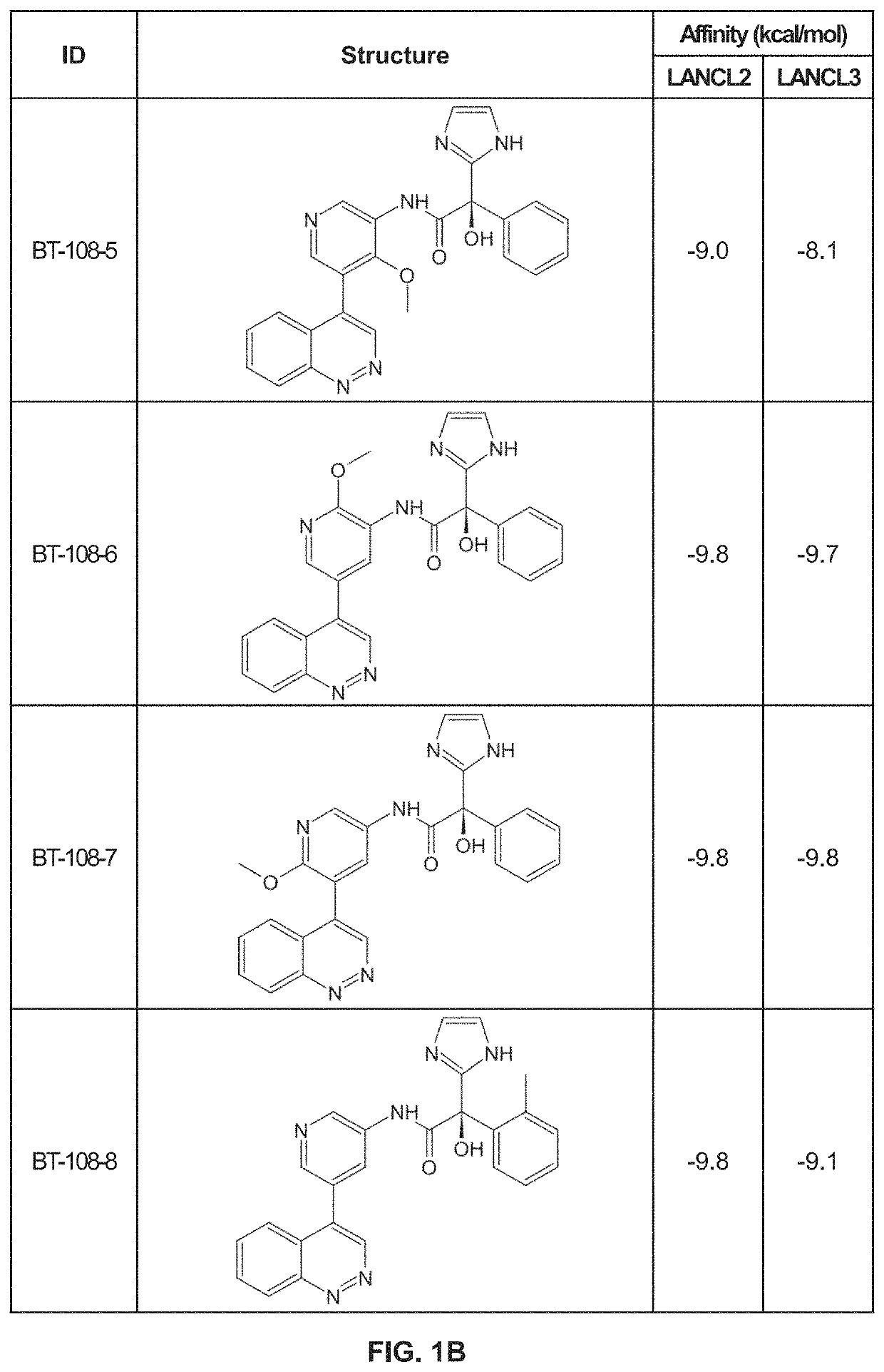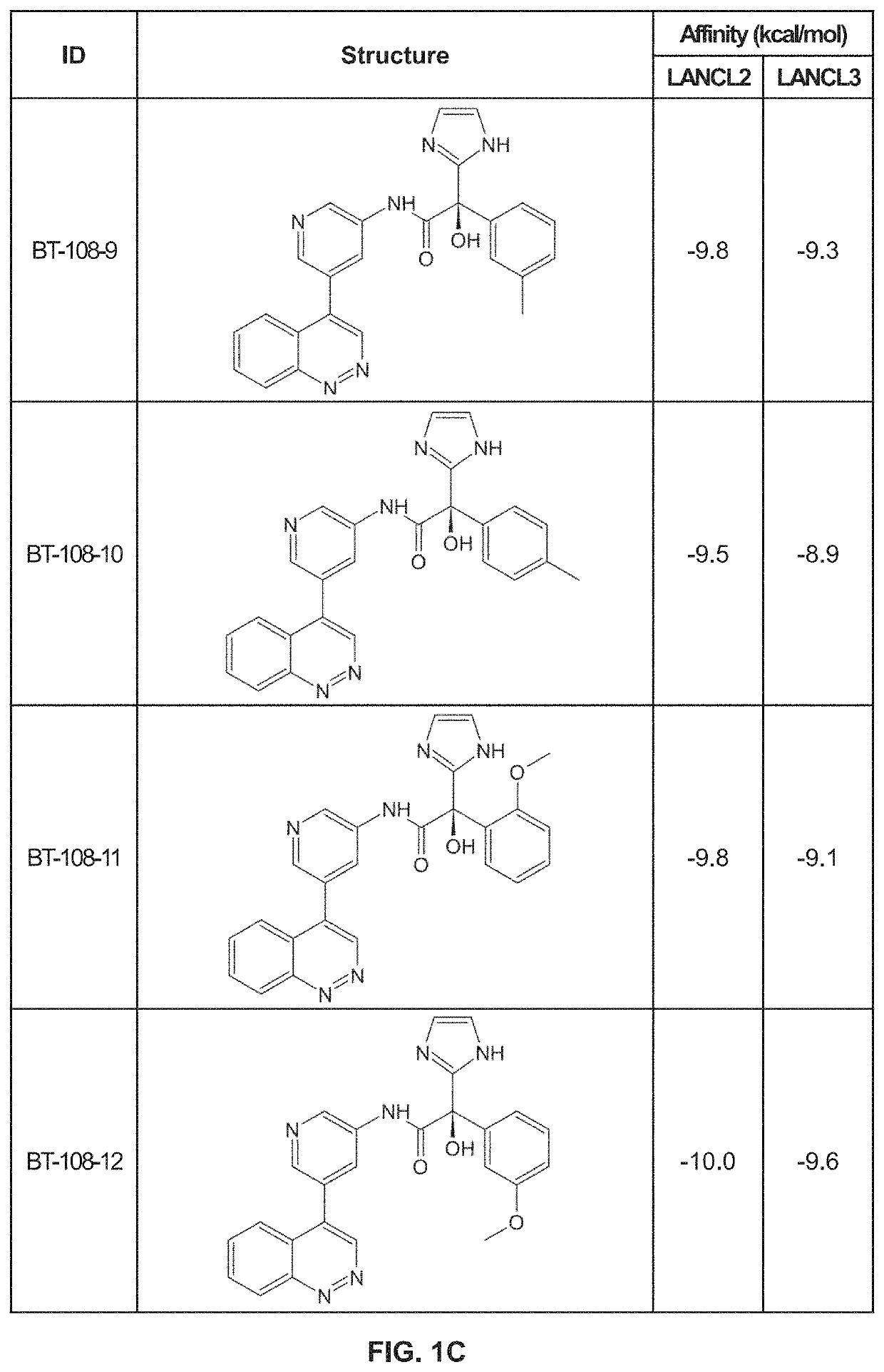LANCL ligands
a technology of lanthionine synthetase and lancl, which is applied in the field of lancl ligands, can solve the problems of poor safety, shifting treatment paradigms, and complex delivery methods, and the current autoimmune treatment requires frequent monitoring
- Summary
- Abstract
- Description
- Claims
- Application Information
AI Technical Summary
Benefits of technology
Problems solved by technology
Method used
Image
Examples
example 1
Molecular Modeling of LANCL Ligands
[0164]Using previously described ligands of LANCL2, including abscisic acid, we determined the existence of a high affinity binding site in LANCL2. We identified a binding pocket with similar biochemistry in the structure of LANCL3. Using the shape, residues and polarity of these binding pockets, we developed a novel scaffold. Derivatives of this scaffold were then docked in silico to the LANCL2 and LANCL3 structures.
Methods
[0165]Virtual Screening. To provide additional insights into preliminary scaffolds, ligand databases were docked onto LANCL2 and LANCL3 using AutoDock Vina at each of the two sites using cuboid search grid of size (58×40×40 angstrom) to provide predicted binding affinities and conformations of ligands. Binding affinity was normalized to molecular weight of the ligand. Top ligands were selected for further examination of binding pose.
[0166]Compound generation. From the identified residues and predicted biochemical interactions, s...
example 2
BT-108-1
[0169]The synthesis of BT-108-1 (FIG. 2A) was a five step process as detailed below.
[0170]Bispinacolatodiboron and potassium acetate were charged to a stirred solution of 5-bromopyridin-3-amine in 1, 4-dioxane. After adding PdCl2(dppf), the reaction mixture was purged with nitrogen gas. The reaction mass was heated to 80° C. After completion of reaction, mixture was cooled to 25° C.-30° C., filtered through celite bed and washed with ethyl acetate to afford 5-aminopyridin-3-yl)boronic acid.
[0171]A stirred solution of 4-chlorocinnoline, 5-aminopyridin-3-yl)boronic acid and potassium carbonate in water / 1,4-dioxane (8:2 V) was purged with nitrogen gas. After adding PdCl2(dppf), the reaction mixture was purged with nitrogen gas. The reaction mass was heated to 80° C. After completion of reaction, mixture was cooled to 25° C.-30° C., filtered through celite bed and washed with ethyl acetate to afford 5-(cinnolin-4-yl)pyridin-3-amine.
[0172]TEA was added to a solution of 5-(cinnoli...
example 3
BT-108-2
[0175]The synthesis of BT-108-2 (FIG. 2B) was a five step process as detailed below.
[0176]Bispinacolatodiboron and potassium acetate were charged to a stirred solution of 5-bromo-4-methylpyridin-3-amine in 1,4-dioxane. After adding PdCl2(dppf), the reaction mixture was purged with nitrogen gas. The reaction mass was heated to 80° C. After completion of reaction, mixture was cooled to 25° C.-30° C., filtered through celite bed and washed with ethyl acetate to afford (4-methylpyridin-3-amine-5-yl)boronic acid.
[0177]A stirred solution of 4-chlorocinnoline, (4-methylpyridin-3-amine-5-yl)boronic acid and potassium carbonate in water / 1,4-dioxane (8:2 V) was purged with nitrogen gas. After adding PdCl2(dppf), the reaction mixture was purged with nitrogen gas. The reaction mass was heated to 80° C. After completion of reaction, mixture was cooled to 25° C.-30° C., filtered through celite bed and washed with ethyl acetate to afford 5-(cinnolin-4-yl)-4-methylpyridin-3-amine.
[0178]TEA ...
PUM
| Property | Measurement | Unit |
|---|---|---|
| size | aaaaa | aaaaa |
| temperature | aaaaa | aaaaa |
| concentration | aaaaa | aaaaa |
Abstract
Description
Claims
Application Information
 Login to View More
Login to View More - R&D
- Intellectual Property
- Life Sciences
- Materials
- Tech Scout
- Unparalleled Data Quality
- Higher Quality Content
- 60% Fewer Hallucinations
Browse by: Latest US Patents, China's latest patents, Technical Efficacy Thesaurus, Application Domain, Technology Topic, Popular Technical Reports.
© 2025 PatSnap. All rights reserved.Legal|Privacy policy|Modern Slavery Act Transparency Statement|Sitemap|About US| Contact US: help@patsnap.com



